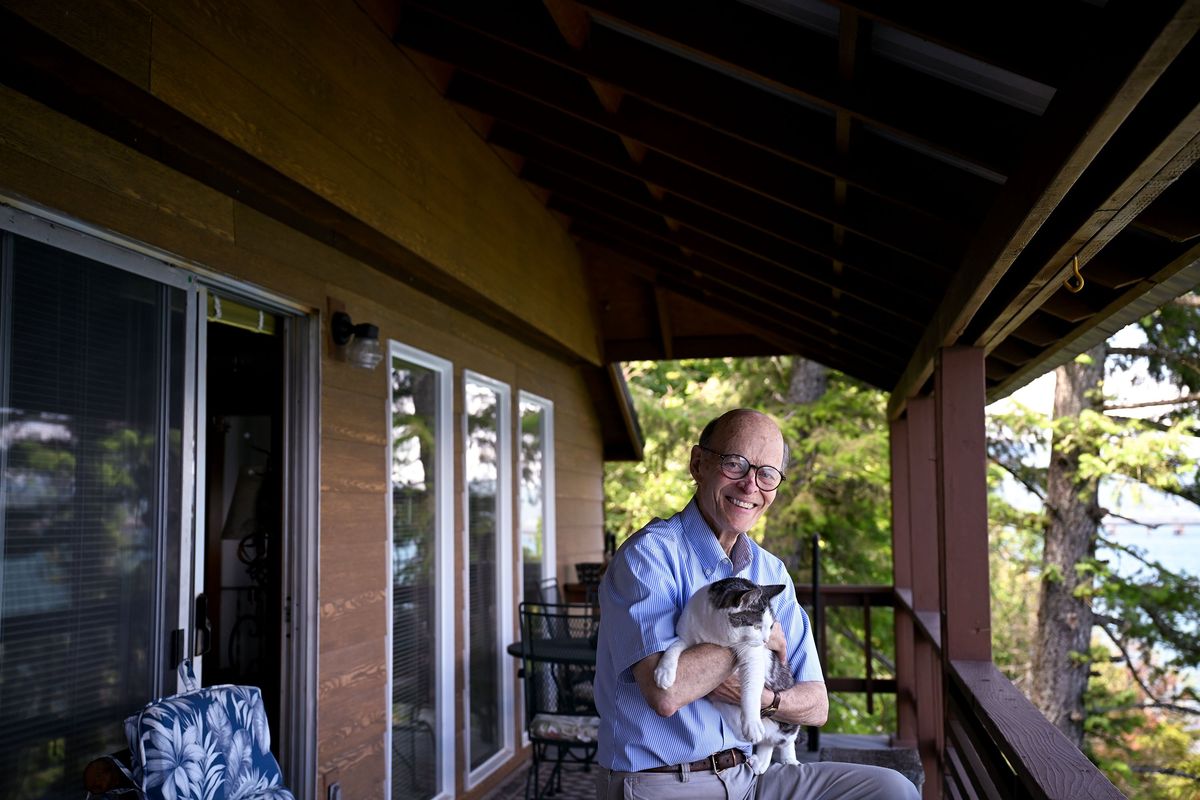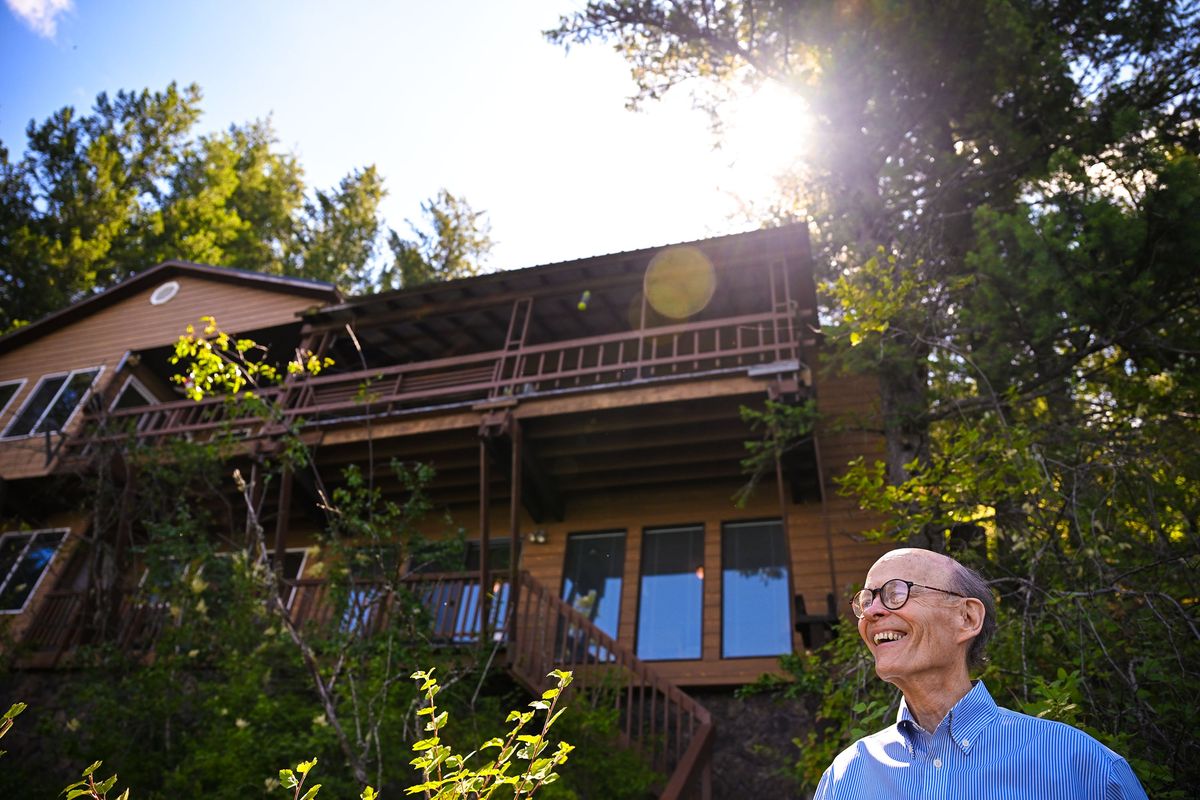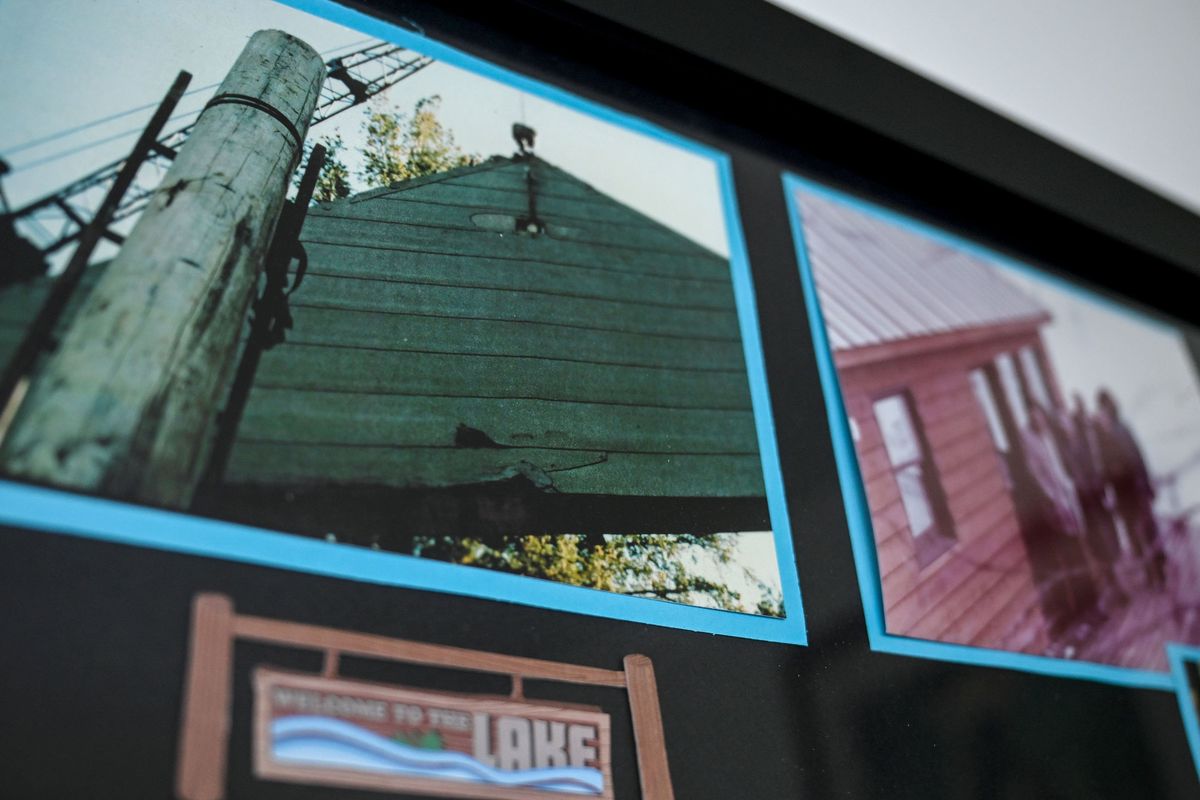‘Nowhere on Earth I’d rather be’: Man turns $250 collapsible post office from Expo ‘74 into cabin on Lake Pend Oreille
Mark Conlin smiles Tuesday as he remembers using the Expo ’74 post office building as a building block for his family cabin on Lake Pend Oreille in Sagle, Idaho. (Kathy Plonka/The Spokesman-Review)
In March 1975, Mark Conlin bought what served as the official post office during Spokane’s Expo ’74 for $250. The building was one of many made to be dismantled after the event, and Conlin had just the idea in mind for its future – a cabin on Lake Pend Oreille.
Conlin, 77, followed through with his vision, and today, nearly 50 years later, the post office stands as the central component of a two-bedroom house on a cliff overlooking Lake Pend Oreille. The outwardly unassuming house is not only structurally based on the Expo ’74 building, but also features windows and tables fashioned from doorframes of one of the old Paulsen Buildings in downtown Spokane, a salvaged fire escape staircase down to the water and handmade guardrails on a ladder fashioned from the handles of Conlin’s mother’s casket.
“I know exactly where those are going,” he said when he was offered the handles.
Most everything in Conlin’s cabin has a story, from the hardwood ceiling to the water pipes in the basement. Despite the eclectic history of the structure and its furnishings, nothing seems out of place, and the floors were polished clean when a reporter visited last week. White and gray shorthair cat Pixie lazed on a dining chair. Conlin calls her his guard cat, though he admits she is not good at her job, hardly bothering to raise her head at a disturbance.
Many of the decorative items around the house were once trash that Conlin found beauty in and was able to give new life.
“What does that look like to you?” he asked of a wooden log with plastic eyes added to it on display in the corner of the room. “A broken-off piling, or a dragon?”
Moving to Spokane when he was 3 in 1949, Conlin spent the summers of his youth at a friend’s cabin on Lake Pend Oreille and had what he calls “the greatest time.” After high school, he left behind his civilian life to join the Marine Corps, touring Vietnam from 1967 to 1968 and witnessing the Tet Offensive.
“I just kept thinking about Lake Pend Oreille,” Conlin said about his time in service. “Just the good times there, and just felt, ‘Boy, that was a place where I’d like to have a place.’ ”
As if by fate, when returning home from the war, Conlin happened across an advertisement for two plots of land on Lake Pend Oreille. The land was steep and called by some “unbuildable,” but Conlin jumped on the offer. With no plan in place, Conlin met the seller on site and scribbled down a purchasing agreement on a loose napkin. He remembers when he took his late wife Kathy to the land for the first time.
“I was so proud, and so I wanted to drive her up,” Conlin said. “She stood at the edge of the road and looked over the bank and looked at me and said, ‘We bought this?’ ”
The following year, Conlin attended an auction for some collapsible buildings that were used in Spokane’s world’s fair.
In a spot known as the services area of the fair, there were a number of small buildings designed to be torn down after use. They hosted buildings for Hughes Airline, the American Association of Retired Persons and a currency exchange spot, among other organizations, according to the Expo ’74 site map.
Conlin was drawn to what had been the 24-by-24-foot wooden U.S. Postal Service building in the services area as a potential base for a cabin on the lake plot.
“I walked into the post office and looked up at the ceiling, and it was this stunning, beautiful, vertical grain fir tongue and groove ceiling,” Conlin said. “None of the other buildings had that.”
Being one of few who was willing to brave the rain and wind to attend the auction, Conlin placed a bid for $250 and got the building uncontested. He loaded the flat pieces onto a flatbed and hauled them out to his land with the help of friends and family.
The building team consisted of Conlin, his brother, his cousin and several friends with expertise in different aspects of construction.
“It’s amazing what you can do with good friends and a big brother,” Conlin said about the process of turning the wooden shell into a stable cabin.
“We were young then,” Conlin said. “ …I had friends that knew wiring and electrical, and another one that could design a building – a house, a shop – without blueprints.”
The initial structure of the cabin was just the ceiling and walls of the post office building from Expo ’74, supported on the side of the cliff by nine large wooden poles. Conlin recalled all of his friends sleeping in bags on the original deck during construction, joking that it was a good thing nobody was a sleepwalker since there were no safety railings up .
Northwest Museum of Arts and Culture Curator Anna Harbine was excited to hear that Conlin has maintained use for a building from Expo ’74, as she said that many of them were simply not designed to last.
“The whole point of the Expo ’74 design was to leave as little of a footprint as possible,” Harbine said. “There are not a lot of buildings that have survived.”
Over the following years, Conlin and his friends continued to add on to the house, primarily using items scavenged from demolition sites of local buildings.
One such salvaged item from a bank in Tekoa, Washington, is an oak wood toilet, which Conlin refers to as his “bank assset.” Another salvage with strong presence all across the cabin is a series of door frames from the old Paulsen Center . Conlin’s brother, a woodworker, was able to turn a piece of the frame into a sturdy coffee table, and other frames now make up the dividers in a series of windows overlooking the water. A friend of his wound up with large amounts of timber, so they decided to add on a basement level to the house.
Although much of the house was made by Conlin , he said that his lack of experience has led to some humorous situations.
“I have to be supervised,” he said. In one instance, he attempted to set up the water system on his own and called over a couple of plumbers to double-check his work. He heard them laughing, and they told him, “It all looks good, but you’re running hot water to the toilet.”
After hiring professionals to add two bedrooms to the side of the cabin in recent years, Conlin said the longtime project has finally reached completion. Although he regrets that Kathy was not alive to see it, last summer Conlin accomplished a longtime goal to have six generations of his family visit the cabin through the years – from his grandmother to his great-grand-nephews.
“She was there in spirit,” he said of his wife, citing the “beautiful weather” and celebration that his friends and family threw to commemorate the occasion.
These days, Conlin finds himself occupied “trying to control that annoying cat,” Pixie, who is wanting treats at 2:30 a.m., and watching the airshows put on by the local swallows in the mornings.
“I’s been an awful lot of fun,” Conlin said. “I get up here, and sometimes, there’s nowhere on Earth I’d rather be.”



